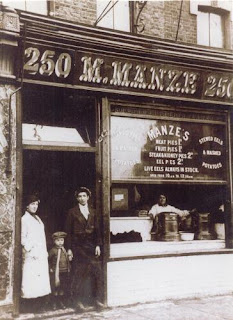This recipe is an update of the famous London dish – jellied eels. I have never tried them before and thought it rather a shame that the classic recipe isn’t in the book. Jellied eel is particularly associated with the East End of London though it was eaten throughout the city and appeared sometime in the eighteenth century. At that time, the Thames was crawling with eels and therefore many, many recipes were created. When eel consumption reached a peak during the Victorian era, the Thames had become pretty disgusting with pollution and there were not many eels around, so they had be imported from Ireland. These days, most Irish eels are exported to Holland.
If you wanted to buy jellied eels in London, you would have had to go to an Eel Pie and Mash House. There not many around – they declined in number from over a hundred after the Second World War to just a handful today. The most famous – and London’s oldest – extant Eel and Pie House is Manze’s in Peckham. I have never been to one of these places, but I shall try my best to frequent Manze’s next time I pop down to London. I doubt if they will ever regain popularity, even though eels have now returned to the River Thames.
Inside Menzie's (photo from The Guardian)
This is an ‘updated’ recipe from chef Guy Mouilleron, who apparently thought of an eel slithering through a bank of watercress and thought the two might might together. The recipe is outdated; fish mousses are certainly a thing of the 1970s and 1980s; when English Food was first published.
Eels are quite difficult to get hold of, but the massive Asian supermarket in St Louis has farmed live ones – luckily I didn’t have to do away with them as I had to for the first time I cooked an eel dish. There is one more eel dish to do in the book, so I suppose I shall be trying that one soon.
To make the mousse, you need to prepare your eels. You’ll need around 2 ½ pounds of eel altogether. If you can get the fishmonger to skin and fillet them for you, all’s the better. I didn’t have such a luxury, but found it quite easy now that I have had certain amount of experience with eel preparation. First of all, give them a wash and wipe away any slime that may remain on the skin. To skin an eel, you first need to cut through the skin all around its neck, behind the gills. Next, either nail the head to a wooden chopping board or grasp the head with a tea-towel. Now you need to pull on the cut skin and peel the skin off like a stocking. It is quite difficult to get a purchase, so sprinkle the neck liberally with salt to create some much-needed friction. Once skinned, it is pretty easy going after that; gut it, cutting from the head-end to an inch or so past the vent so that the kidneys as well as the other internal organs can be removed. Filleting was a bit tricky – but really it was just like filleting any fish really. Use a sharp knife and cut from the head end to the tail end, pressing down on the fish with your other hand, which creates pressure and makes the cut much easier to make.Cut away about a third of the messy parts and use trimmings to make the mousse itself.
To do this, you need to liquidise them in a blender along with three egg whites. You will produce a rather bad-looking blob of grey matter.
Place it in a bowl that is sitting in iced water. Whip ¾ of a pint of double cream until it is thick, but not stiff, and fold it into the eel mixture slowly. Season the purée and the neat eel pieces with salt, pepper and nutmeg.
All is prepared now for the construction of the mousse: you need to use a terrine for this, or failing that, a small loaf tin. If you want to turn out the mousse onto a serving dish, it is best to line it with cling film (don’t worry, it won’t melt). Now spread a third of the mixture over the bottom of the terrine and then add half of the eel fillets, then more mixture and so on, until all is used up.
Cover the terrine or tin with a double-layer of foil and then steam it for 1 ¼ hours. I used a fish kettle for this, but if you don’t have something appropriate, you can pop it in a roasting tin containing boiling water and bake it at 160-180⁰C (325-350⁰F). When cold, put it in the fridge overnight.
The next day, make the sauce. You need a good-sized bunch of watercress. From the bunch, pick and reserve enough leaves to make around a tablespoon when chopped. The rest, liquidise in the blender, using the smallest amount of water possible. Pass the watercress slurry through a sieve and add ¼ pint of double cream and whisk it until it thickens. Season and stir through the reserved, chopped leaves. Serve a slice of the mousse with a generous spoonful of the sauce.
#313 Jellied Eel Mousse with Watercress Sauce. My God, what a sight that one was! It looked like a massive chunk of cat food and the sauce was so garish. The taste of the mousse wasn’t too bad, but the texture seemed so wrong. If it had been eaten warm as a creamy stew, it probably would have been delicious. The mild fish and the grassy watercress did not go together in my opinion. A big shame because was waiting to be surprised by its loveliness. I think I would have been happier with some proper jellied eels. Keep the fish mousse where it belongs: in the past! 2/10












No comments:
Post a Comment